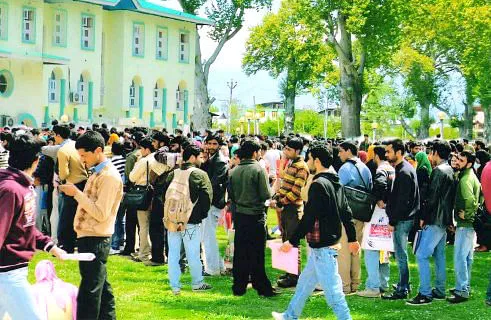The newly announced National Education Policy (NEP) 2020 aims to increase the Gross Enrolment Ratio (GER) to 50 percent by 2035 in the higher education sector. The NEP envisages several positive changes in the education sector at school and higher education level.
So the motive to increase the GER in coming years will be such a positive thing which can bring reforms in the overall education sector and create Human Resource for companies and other allied sectors.
In other developed states and countries, the GER has improved over the years is impressively high and contributes for the growth of the country.
GER is the ratio of the number of enrolments in higher education to the total population in the age group of 18-23 years. Generally, a high GER indicates a high degree of participation.
But in the case of J&K, the situation is altogether different. As per the All India Survey on Higher Education (AISHE), there are around 14 lakh youth in the age group of 18-23 years. But out of these 14 lakh youth only five lakh youth are pursuing higher education in colleges within J&K and outside states as well.
These include those students of J&K who are pursuing undergraduate courses through Prime Ministers Special Scholarship Scheme (PMSSS) in outside colleges and also those enrolled in distance learning institutes like IGNOU and MANUU. So, going by the present statistics, only 31 percent of the youth in the age group of 18-23 years, only 31 percent youth are enrolled in higher education institutions.
The figures have thrown a major challenge for the J&K government to improve the GER in coming years as targeted in the NEP-2020.
Taking into account the number of students enrolled with J&K colleges, the situation seems to be very grim as compared to other states.
There are around 140 degree colleges including newly established 50 colleges, functional in J&K Union Territory (UT) and approximately only 1.82 lakh students. The present enrollment in colleges within J&K speaks volumes about the poor GER and efforts are needed to improve the percentage to the extent as targeted in NEP-2020.
Despite witnessing a huge expansion in colleges, the GER in J&K is very low which has exposed the poor response of the students towards these colleges. The present status has raised a concern that whether it is possible to have GER of 50 percent by 2030.
The GER is a parameter for measuring the access of youth to higher education, especially for developing countries and suggests alternate ways for measuring enrolments in higher education systems.
But there is every reason to aim for a higher GER which is still below the level that could be compared to other states.
And the J&K government needs to make the colleges the centre of attraction for the students besides the centre of excellence to improve the GER in J&K.
Though the government established 50 new degree colleges two years ago, these institutions have failed to attract the students for admissions. The students still prefer outside colleges over the local institutions to pursue their higher education courses.
The quality of higher education should be the hallmark of policy for any state or UT. The higher educational institutions should be of such a high level that these institutions should attract students at international level which will contribute to enrolments and hence higher GER.
Given the time frame in the NEP for states and UTs to improve the GER up to 50 percent, the J&K government should focus on increasing infrastructural facilities in the new degree colleges besides strengthening the available infrastructure in the old existing colleges.
The government should also take steps to get some share in PMSSS wherein students pursue their higher education courses free of cost but the institutions get the funding from AICTE as fee of the students. The amount is utilized by the outside colleges on infrastructural up gradation of the institutions.
If the J&K government will succeed in getting shares in PMSSS for J&K colleges it will increase the inflow of the funding and also increase the enrollment of the local colleges.
With the launch of NEP-2020, major reforms are expected in the education sector with the introduction of multi disciplinary courses for the students from the second year of graduation.
The vision of the NEP-2020 is to end the fragmentation of higher education by introducing skilled courses which students can opt along with the main course at the undergraduate level. With the proper implementation of the NEP-2020 every higher educational institution will become a centre of excellence by introducing skilled courses having higher eligibility for jobs in the industry sector. Besides, every individual graduating from the colleges will be made self sustainable instead of being considered as a liability for the government to provide jobs.
Given the present scenario of higher education in J&K and the launch of NEP-2020, one can hope that the new initiatives will help to achieve the desired GER which is essential for any state or UT. The improved GER will ensure better human resource and increase the potential of producing better researchers and academics besides skilled people who will help in the development of the economy and the knowledge of the J&K.






